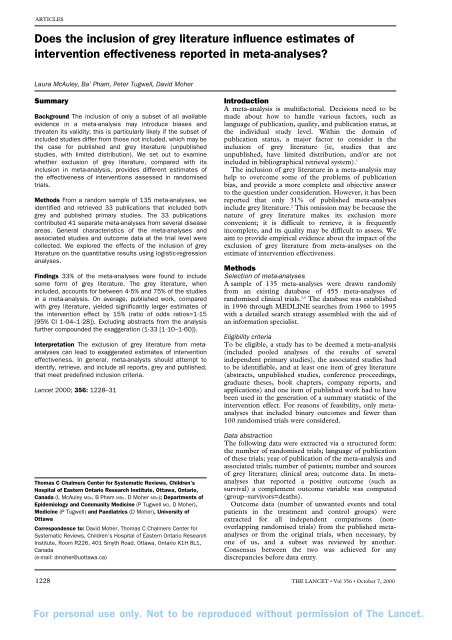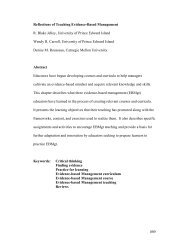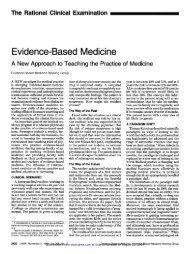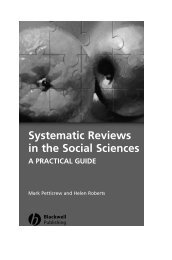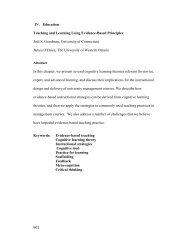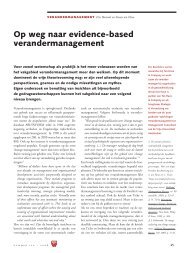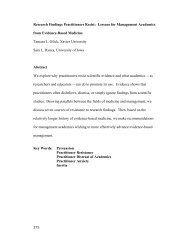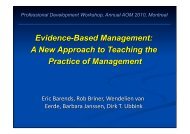Does the inclusion of grey literature influence estimates of ...
Does the inclusion of grey literature influence estimates of ...
Does the inclusion of grey literature influence estimates of ...
You also want an ePaper? Increase the reach of your titles
YUMPU automatically turns print PDFs into web optimized ePapers that Google loves.
ARTICLES<br />
<strong>Does</strong> <strong>the</strong> <strong>inclusion</strong> <strong>of</strong> <strong>grey</strong> <strong>literature</strong> <strong>influence</strong> <strong>estimates</strong> <strong>of</strong><br />
intervention effectiveness reported in meta-analyses<br />
Laura McAuley, Ba’ Pham, Peter Tugwell, David Moher<br />
Summary<br />
Background The <strong>inclusion</strong> <strong>of</strong> only a subset <strong>of</strong> all available<br />
evidence in a meta-analysis may introduce biases and<br />
threaten its validity; this is particularly likely if <strong>the</strong> subset <strong>of</strong><br />
included studies differ from those not included, which may be<br />
<strong>the</strong> case for published and <strong>grey</strong> <strong>literature</strong> (unpublished<br />
studies, with limited distribution). We set out to examine<br />
whe<strong>the</strong>r exclusion <strong>of</strong> <strong>grey</strong> <strong>literature</strong>, compared with its<br />
<strong>inclusion</strong> in meta-analysis, provides different <strong>estimates</strong> <strong>of</strong><br />
<strong>the</strong> effectiveness <strong>of</strong> interventions assessed in randomised<br />
trials.<br />
Methods From a random sample <strong>of</strong> 135 meta-analyses, we<br />
identified and retrieved 33 publications that included both<br />
<strong>grey</strong> and published primary studies. The 33 publications<br />
contributed 41 separate meta-analyses from several disease<br />
areas. General characteristics <strong>of</strong> <strong>the</strong> meta-analyses and<br />
associated studies and outcome data at <strong>the</strong> trial level were<br />
collected. We explored <strong>the</strong> effects <strong>of</strong> <strong>the</strong> <strong>inclusion</strong> <strong>of</strong> <strong>grey</strong><br />
<strong>literature</strong> on <strong>the</strong> quantitative results using logistic-regression<br />
analyses.<br />
Findings 33% <strong>of</strong> <strong>the</strong> meta-analyses were found to include<br />
some form <strong>of</strong> <strong>grey</strong> <strong>literature</strong>. The <strong>grey</strong> <strong>literature</strong>, when<br />
included, accounts for between 4·5% and 75% <strong>of</strong> <strong>the</strong> studies<br />
in a meta-analysis. On average, published work, compared<br />
with <strong>grey</strong> <strong>literature</strong>, yielded significantly larger <strong>estimates</strong> <strong>of</strong><br />
<strong>the</strong> intervention effect by 15% (ratio <strong>of</strong> odds ratios=1·15<br />
[95% CI 1·04–1·28]). Excluding abstracts from <strong>the</strong> analysis<br />
fur<strong>the</strong>r compounded <strong>the</strong> exaggeration (1·33 [1·10–1·60]).<br />
Interpretation The exclusion <strong>of</strong> <strong>grey</strong> <strong>literature</strong> from metaanalyses<br />
can lead to exaggerated <strong>estimates</strong> <strong>of</strong> intervention<br />
effectiveness. In general, meta-analysts should attempt to<br />
identify, retrieve, and include all reports, <strong>grey</strong> and published,<br />
that meet predefined <strong>inclusion</strong> criteria.<br />
Lancet 2000; 356: 1228–31<br />
Thomas C Chalmers Center for Systematic Reviews, Children’s<br />
Hospital <strong>of</strong> Eastern Ontario Research Institute, Ottawa, Ontario,<br />
Canada (L McAuley MSc, B Pham MSc, D Moher MSc); Departments <strong>of</strong><br />
Epidemiology and Community Medicine (P Tugwell MD, D Moher),<br />
Medicine (P Tugwell) and Paediatrics (D Moher), University <strong>of</strong><br />
Ottawa<br />
Correspondence to: David Moher, Thomas C Chalmers Center for<br />
Systematic Reviews, Children’s Hospital <strong>of</strong> Eastern Ontario Research<br />
Institute, Room R226, 401 Smyth Road, Ottawa, Ontario K1H 8L1,<br />
Canada<br />
(e-mail: dmoher@uottawa.ca)<br />
Introduction<br />
A meta-analysis is multifactorial. Decisions need to be<br />
made about how to handle various factors, such as<br />
language <strong>of</strong> publication, quality, and publication status, at<br />
<strong>the</strong> individual study level. Within <strong>the</strong> domain <strong>of</strong><br />
publication status, a major factor to consider is <strong>the</strong><br />
<strong>inclusion</strong> <strong>of</strong> <strong>grey</strong> <strong>literature</strong> (ie, studies that are<br />
unpublished, have limited distribution, and/or are not<br />
included in bibliographical retrieval system). 1<br />
The <strong>inclusion</strong> <strong>of</strong> <strong>grey</strong> <strong>literature</strong> in a meta-analysis may<br />
help to overcome some <strong>of</strong> <strong>the</strong> problems <strong>of</strong> publication<br />
bias, and provide a more complete and objective answer<br />
to <strong>the</strong> question under consideration. However, it has been<br />
reported that only 31% <strong>of</strong> published meta-analyses<br />
include <strong>grey</strong> <strong>literature</strong>. 2 This omission may be because <strong>the</strong><br />
nature <strong>of</strong> <strong>grey</strong> <strong>literature</strong> makes its exclusion more<br />
convenient; it is difficult to retrieve, it is frequently<br />
incomplete, and its quality may be difficult to assess. We<br />
aim to provide empirical evidence about <strong>the</strong> impact <strong>of</strong> <strong>the</strong><br />
exclusion <strong>of</strong> <strong>grey</strong> <strong>literature</strong> from meta-analyses on <strong>the</strong><br />
estimate <strong>of</strong> intervention effectiveness.<br />
Methods<br />
Selection <strong>of</strong> meta-analyses<br />
A sample <strong>of</strong> 135 meta-analyses were drawn randomly<br />
from an existing database <strong>of</strong> 455 meta-analyses <strong>of</strong><br />
randomised clinical trials. 3,4 The database was established<br />
in 1996 through MEDLINE searches from 1966 to 1995<br />
with a detailed search strategy assembled with <strong>the</strong> aid <strong>of</strong><br />
an information specialist.<br />
Eligibility criteria<br />
To be eligible, a study has to be deemed a meta-analysis<br />
(included pooled analyses <strong>of</strong> <strong>the</strong> results <strong>of</strong> several<br />
independent primary studies), <strong>the</strong> associated studies had<br />
to be identifiable, and at least one item <strong>of</strong> <strong>grey</strong> <strong>literature</strong><br />
(abstracts, unpublished studies, conference proceedings,<br />
graduate <strong>the</strong>ses, book chapters, company reports, and<br />
applications) and one item <strong>of</strong> published work had to have<br />
been used in <strong>the</strong> generation <strong>of</strong> a summary statistic <strong>of</strong> <strong>the</strong><br />
intervention effect. For reasons <strong>of</strong> feasibility, only metaanalyses<br />
that included binary outcomes and fewer than<br />
100 randomised trials were considered.<br />
Data abstraction<br />
The following data were extracted via a structured form:<br />
<strong>the</strong> number <strong>of</strong> randomised trials; language <strong>of</strong> publication<br />
<strong>of</strong> <strong>the</strong>se trials; year <strong>of</strong> publication <strong>of</strong> <strong>the</strong> meta-analysis and<br />
associated trials; number <strong>of</strong> patients; number and sources<br />
<strong>of</strong> <strong>grey</strong> <strong>literature</strong>; clinical area; outcome data. In metaanalyses<br />
that reported a positive outcome (such as<br />
survival) a complement outcome variable was computed<br />
(group–survivors=deaths).<br />
Outcome data (number <strong>of</strong> unwanted events and total<br />
patients in <strong>the</strong> treatment and control groups) were<br />
extracted for all independent comparisons (nonoverlapping<br />
randomised trials) from <strong>the</strong> published metaanalyses<br />
or from <strong>the</strong> original trials, when necessary, by<br />
one <strong>of</strong> us, and a subset was reviewed by ano<strong>the</strong>r.<br />
Consensus between <strong>the</strong> two was achieved for any<br />
discrepancies before data entry.<br />
1228 THE LANCET • Vol 356 • October 7, 2000<br />
For personal use only. Not to be reproduced without permission <strong>of</strong> The Lancet.
ARTICLES<br />
MA level (n=33)<br />
Number <strong>of</strong> RCTs per MA (median [IQR]) 10 (6–19)<br />
Number <strong>of</strong> patients per MA (median [IQR]) 1463 (1120–3163)<br />
Clinical area (frequency)<br />
Gastrointestinal 24·2%<br />
Cardiac 21·2%<br />
Infection 12·1%<br />
Reproduction 12·1%<br />
Circulatory 9·1%<br />
Number <strong>of</strong> sources <strong>of</strong> <strong>grey</strong> <strong>literature</strong> per MA (median [IQR]) 1 (1–2)<br />
Number <strong>of</strong> <strong>grey</strong> items per MA (median [IQR]) 2 (1–3)<br />
Year <strong>of</strong> publication <strong>of</strong> MA (median [IQR]) 1993 (1991–1994)<br />
Interventon comparisons<br />
Published MA with one comparison 27<br />
Published MA with two independent comparisons 4<br />
Published MA with three independent comparisons 2<br />
MA=meta-analysis. RCT=randomised clinical trial.<br />
Table 1: General characteristics <strong>of</strong> meta-analyses<br />
The main outcome was defined as <strong>the</strong> one stated as<br />
such by <strong>the</strong> investigators, or if <strong>the</strong>re was no such<br />
statement, <strong>the</strong> most clinically relevant was used (mortality<br />
would be selected over morbidity); if no outcome was<br />
clinically relevant, <strong>the</strong>n <strong>the</strong> one contributing <strong>the</strong> most<br />
patients was used. 5<br />
Data analyses<br />
We replicated <strong>the</strong> published meta-analyses as a qualitycontrol<br />
measure. After completing <strong>the</strong> replication, each<br />
meta-analyses was repeated with all <strong>grey</strong> items removed,<br />
which allowed us to examine <strong>the</strong> effect <strong>of</strong> <strong>grey</strong> <strong>literature</strong><br />
on <strong>estimates</strong> <strong>of</strong> <strong>the</strong> intervention effect. By <strong>the</strong> use <strong>of</strong> a<br />
logistic-regression model, <strong>the</strong> log odds <strong>of</strong> unwanted events<br />
experienced by each treatment group were related to trial,<br />
intervention, meta-analysis, and <strong>grey</strong> <strong>literature</strong>.<br />
Differences in <strong>the</strong> intervention effect across <strong>the</strong> metaanalyses<br />
were accounted for by an interaction effect<br />
between intervention and meta-analysis. An interaction<br />
term between <strong>grey</strong> <strong>literature</strong> and intervention was<br />
included to capture <strong>the</strong> potential that <strong>grey</strong> <strong>literature</strong> could<br />
modify <strong>estimates</strong> <strong>of</strong> intervention effectiveness. This effect<br />
was expressed as a ratio <strong>of</strong> intervention effect odds ratios<br />
(ie, ratio <strong>of</strong> odds ratios [ROR]) between <strong>grey</strong> and<br />
published <strong>literature</strong>. 6,7 With this modelling convention, an<br />
odds ratio less than 1·0 showed that <strong>the</strong> intervention was<br />
more effective than <strong>the</strong> control in preventing an unwanted<br />
event. Consequently, an ROR between <strong>grey</strong> and<br />
published <strong>literature</strong> greater than 1·0 indicated that, on<br />
average, <strong>estimates</strong> <strong>of</strong> intervention effectiveness from <strong>grey</strong><br />
<strong>literature</strong> were smaller than <strong>the</strong>ir corresponding <strong>estimates</strong><br />
from published work. The results from <strong>the</strong> unconditional<br />
models described above were verified by a conditional<br />
logistic-regression approach (not reported). We also<br />
completed a sensitivity analysis—we assessed <strong>the</strong> potential<br />
effect <strong>of</strong> abstracts as <strong>the</strong> source <strong>of</strong> <strong>grey</strong> <strong>literature</strong>, relative<br />
to published <strong>literature</strong>.<br />
Standard residual diagnostics were used to assess <strong>the</strong><br />
model’s goodness <strong>of</strong> fit. ROR and its 95% CIs were<br />
derived from <strong>the</strong> fitted model. To assess <strong>the</strong> impact <strong>of</strong><br />
<strong>grey</strong> <strong>literature</strong> on <strong>the</strong> variable “no intervention effect”,<br />
Z scores were derived (ie, intervention effect size divided<br />
by its SE) from a meta-analysis with and without <strong>grey</strong><br />
<strong>literature</strong>. The Z scores were <strong>the</strong>n compared statistically<br />
by paired t test. The conditional logistic-regression<br />
analyses (data not reported) were done in LogXact, all<br />
o<strong>the</strong>r analyses in S-Plus 2000.<br />
Results<br />
From <strong>the</strong> original 135 meta-analyses retrieved, we could<br />
not establish whe<strong>the</strong>r <strong>grey</strong> <strong>literature</strong> was included in 12<br />
cases (11 poorly referenced, one not retrieved). An<br />
additional eight meta-analyses were excluded because<br />
<strong>the</strong>y did not fit <strong>the</strong> definition <strong>of</strong> a meta-analysis. Of <strong>the</strong><br />
remaining 115, 38 (33%) were found to contain at least<br />
one item <strong>of</strong> <strong>grey</strong> <strong>literature</strong>. Five <strong>of</strong> <strong>the</strong>se meta-analyses<br />
failed to meet <strong>the</strong> <strong>inclusion</strong> criteria. For all subsequent<br />
investigations, we used <strong>the</strong> sample <strong>of</strong> 33 publications,<br />
contributing 41 separate and independent meta-analyses<br />
(table 1).<br />
When included, <strong>grey</strong> <strong>literature</strong> accounted for between<br />
4·5% and 75% (median=25% [interquartile range=<br />
16·7–33·3%]) <strong>of</strong> <strong>the</strong> studies in a meta-analysis. For <strong>the</strong><br />
sample as a whole, <strong>grey</strong> <strong>literature</strong> contributed 22% (102<br />
<strong>of</strong> 467) <strong>of</strong> <strong>the</strong> studies and 10·7% (23 286 <strong>of</strong> 217 427) <strong>of</strong><br />
<strong>the</strong> participants (table 2). Grey-<strong>literature</strong> studies tended<br />
to be smaller than published ones. None <strong>of</strong> <strong>the</strong> meta-<br />
RCT level<br />
Overall Grey Published<br />
Total number <strong>of</strong> RCTs 467 102 365<br />
Total number <strong>of</strong> patients 217 427 23 286 194 141<br />
Number <strong>of</strong> patients per RCT (median [IQR]) 106 (55–223) 83·5 (48–190) 113 (59–228)<br />
Number with null or negative results 157 (34·6%) 32 (32·0%) 125 (35·3%)<br />
Year <strong>of</strong> publication* (median [IQR]) 1988 (1985–1990) 1989 (1986–1990) 1988 (1984–1990)<br />
Language <strong>of</strong> publication<br />
English 439 (94·0%) 99 (97·1%) 340 (93·2%)<br />
French 11 (2·4%) 2 (2·0%) 9 (2·5%)<br />
German 9 (2·0%) 0 9 (2·5%)<br />
Spanish 4 (0·9%) 1 (1·0%) 3 (0·8%)<br />
Italian 3 (0·7%) 0 3 (0·8%)<br />
Japanese 1 (0·2%) 0 1 (0·3%)<br />
Frequency <strong>of</strong> <strong>grey</strong> sources<br />
Abstracts & symposia 62%<br />
Unpublished 17%<br />
Book chapters 6%<br />
Reports 5%<br />
Pharmaceutical companies 3%<br />
In press 3%<br />
Letters 2%<br />
Theses 2%<br />
RCT=randomised clinical trial. *Publication indicates a prepared report for all <strong>grey</strong> items.<br />
Table 2: General characteristics <strong>of</strong> randomised trials included in <strong>the</strong> meta-analyses<br />
THE LANCET • Vol 356 • October 7, 2000 1229<br />
For personal use only. Not to be reproduced without permission <strong>of</strong> The Lancet.
ARTICLES<br />
Grey <strong>literature</strong> removed — intervention effect<br />
2·0<br />
1·5<br />
1·0<br />
0·5<br />
0·0<br />
0·0 0·5 1·0 1·5 2·0<br />
Replicated (published + <strong>grey</strong>) — intervention effect<br />
Pooled odds ratios with <strong>grey</strong> <strong>literature</strong> included plotted against<br />
corresponding odds ratios <strong>of</strong> same meta-analyses after<br />
removal <strong>of</strong> <strong>grey</strong> <strong>literature</strong><br />
Size <strong>of</strong> plotting circles is inversely proportional to variance <strong>of</strong> “<strong>grey</strong><br />
<strong>literature</strong> removed” <strong>estimates</strong>.<br />
analyses included more than three sources <strong>of</strong> <strong>grey</strong><br />
<strong>literature</strong>. Most only included one source, usually<br />
abstracts, which accounted for 61% <strong>of</strong> <strong>the</strong> <strong>grey</strong> <strong>literature</strong>.<br />
In <strong>the</strong> sample as a whole, most <strong>of</strong> <strong>the</strong> items were in<br />
English (94·0%); this trend remained when <strong>grey</strong> and<br />
published studies were examined individually.<br />
The replicated <strong>estimates</strong> <strong>of</strong> intervention effectiveness<br />
were very similar to published ones. Of <strong>the</strong> 41 metaanalyses,<br />
discrepancies <strong>of</strong> greater than 10% occurred only<br />
in one case. In this case <strong>the</strong> published report 8 shows a<br />
slightly higher worsening <strong>of</strong> suicidal ideation, although<br />
both <strong>the</strong> published and <strong>the</strong> replicated results are<br />
significant. In a meta-analysis on <strong>the</strong> use <strong>of</strong> -blockers to<br />
prevent mortality in patients with cirrhosis and<br />
endoscopic varices, 9 <strong>the</strong> replication yielded a significant<br />
result in favour <strong>of</strong> treatment (OR=0·71 [95% CI<br />
0·53–0·95]) when <strong>the</strong> published meta-analysis had<br />
reported a non-significant result (0·75 [0·57–1·06]).<br />
In 14 (34%) <strong>of</strong> <strong>the</strong> 41 analyses removal <strong>of</strong> <strong>the</strong> <strong>grey</strong><br />
<strong>literature</strong> changed <strong>the</strong> estimate <strong>of</strong> intervention<br />
effectiveness by 10% or more. In nine <strong>of</strong> <strong>the</strong>se cases,<br />
removal resulted in <strong>the</strong> intervention effect moving away<br />
from unity. In three meta-analyses, <strong>the</strong> exclusion <strong>of</strong> <strong>the</strong><br />
<strong>grey</strong> <strong>literature</strong> resulted in a change in <strong>the</strong> significance <strong>of</strong><br />
<strong>the</strong> results, from non-significant to significant, in two<br />
cases. On average, across 39 meta-analyses (two were<br />
excluded because <strong>the</strong>y contained non-independent trials),<br />
<strong>grey</strong> <strong>literature</strong>, compared with published, yielded a<br />
significantly larger odds-ratio estimate <strong>of</strong> treatment effect<br />
(15%, ROR 1·15 [1·04–1·28]), indicating that treatment<br />
is less effective for preventing an undesirable health<br />
outcome. The implication <strong>of</strong> this average effect on <strong>the</strong><br />
individual meta-analysis is presented in <strong>the</strong> figure. When<br />
we limit <strong>the</strong> analysis to a comparison <strong>of</strong> abstracts and full<br />
publications, <strong>the</strong> estimate <strong>of</strong> intervention effectiveness<br />
(ROR 1·02 [0·91–1·14]) did not change. When abstracts<br />
were removed from this analysis (20 meta-analyses), this<br />
overestimate increased to 33% (1·33 [1·10–1·60]).<br />
A trend towards more significant results after <strong>the</strong><br />
removal <strong>of</strong> <strong>grey</strong> <strong>literature</strong> was found. When <strong>the</strong> Z score<br />
calculated with <strong>the</strong> <strong>grey</strong> <strong>literature</strong> excluded was compared<br />
with <strong>the</strong> Z score <strong>of</strong> <strong>the</strong> RORs (published and inclusive <strong>of</strong><br />
<strong>grey</strong> <strong>literature</strong>) <strong>the</strong>re was a significant decrease in Z scores<br />
(t=7·257, p
ARTICLES<br />
Some limitations <strong>of</strong> this study are actually limitations or<br />
deficiencies <strong>of</strong> <strong>the</strong> published meta-analyses. Poor<br />
referencing <strong>of</strong> included trials led to <strong>the</strong> exclusion <strong>of</strong> eleven<br />
meta-analyses from our sample because we could not find<br />
out which studies were used to generate <strong>the</strong> summary<br />
<strong>estimates</strong>. The <strong>inclusion</strong> <strong>of</strong> <strong>grey</strong> <strong>literature</strong> was incomplete<br />
in at least one <strong>of</strong> <strong>the</strong> included meta-analysis. The<br />
originators <strong>of</strong> this meta-analysis clearly state <strong>the</strong>ir<br />
<strong>inclusion</strong> criteria: “except for two unpublished references,<br />
which were obtained from <strong>the</strong> Diarrhoeal Disease Control<br />
Programme <strong>of</strong> <strong>the</strong> World Health Organization (WHO),<br />
only published reports were considered in an attempt to<br />
ensure <strong>the</strong> quality <strong>of</strong> <strong>the</strong> research”. 16 Although this view is<br />
biased in terms <strong>of</strong> <strong>grey</strong> <strong>literature</strong>, it allows <strong>the</strong> reader to<br />
judge decisions. It is likely that <strong>the</strong>re were similar<br />
conscious or unconscious omissions <strong>of</strong> <strong>grey</strong> <strong>literature</strong> in<br />
o<strong>the</strong>r meta-analyses in this sample. However, we could<br />
not judge how <strong>of</strong>ten this happened.<br />
This work does not address <strong>the</strong> identification and<br />
retrieval <strong>of</strong> <strong>grey</strong> <strong>literature</strong> for those wishing to include it in<br />
future meta-analyses. It may be that <strong>the</strong> time, effort, and<br />
cost involved in identifying, locating, and retrieving <strong>the</strong><br />
<strong>grey</strong> <strong>literature</strong> makes its <strong>inclusion</strong> prohibitive. This is an<br />
important area for future research. Efforts made by<br />
various groups, including <strong>the</strong> Cochrane Collaboration,<br />
through trial registries, negative trial journals, internetbased<br />
<strong>grey</strong> <strong>literature</strong> resources, and <strong>the</strong> policies adopted<br />
by several pharmaceutical companies to prospectively<br />
register trials and make <strong>the</strong>se registers publicly available, 17<br />
may make <strong>the</strong> identification easier. If investigators are<br />
expected to include <strong>grey</strong> <strong>literature</strong>, some guidance should<br />
be available on how to identify and retrieve it.<br />
This work has implications for both meta-analysts and<br />
those who use <strong>the</strong>m to help inform clinical and policy<br />
decisions. In general, <strong>the</strong> meta-analyst should attempt to<br />
ensure a comprehensive <strong>literature</strong> search to avoid <strong>the</strong> effects<br />
<strong>of</strong> selective publication. For those using meta-analyses to<br />
assist with clinical and policy decisions if <strong>grey</strong> <strong>literature</strong> is<br />
not included health-care decisions may be based on overly<br />
optimistic <strong>estimates</strong> <strong>of</strong> treatment effectiveness, which may<br />
have direct consequences for patient care.<br />
Contributors<br />
Laura McAuley completed <strong>the</strong> research as part <strong>of</strong> her MSc <strong>the</strong>sis and as<br />
such she helped develop <strong>the</strong> idea, collect <strong>the</strong> data, participated in all<br />
aspects <strong>of</strong> <strong>the</strong> data analyses and write-up <strong>of</strong> <strong>the</strong> paper. Ba’ Pham<br />
supervised <strong>the</strong> data analyses and did some <strong>of</strong> <strong>the</strong>m. Peter Tugwell was one<br />
<strong>of</strong> Laura’s <strong>the</strong>sis supervisors and helped with <strong>the</strong> interpretation <strong>of</strong> <strong>the</strong><br />
results, and David Moher helped to develop <strong>the</strong> idea, was one <strong>of</strong> Laura’s<br />
<strong>the</strong>sis supervisors, helped to interpret <strong>the</strong> results, and participated in<br />
writing <strong>the</strong> paper.<br />
Acknowledgments<br />
We thank Jon Deeks for commenting on an earlier version <strong>of</strong> this paper,<br />
and Kay Dickersin, Ann McKibbon, and Jesse McGowan for <strong>the</strong>ir input<br />
into <strong>the</strong> definition <strong>of</strong> <strong>grey</strong> <strong>literature</strong>, and Robert Platt and Tong Guo for<br />
help running <strong>the</strong> conditional logistic-regression models.<br />
References<br />
1 Last JM. A dictionary <strong>of</strong> epidemiology, 3rd edn. Oxford: Oxford<br />
University Press, 1995.<br />
2 Cook DJ, Guyatt GH, Ryan G, et al. Should unpublished data be<br />
included in meta-analyses JAMA 1993; 269: 2749–53.<br />
3 Jadad AR, Cook DJ, Jones A, et al. Methodology and reports <strong>of</strong><br />
systematic reviews and meta-analyses: a comparison <strong>of</strong> Cochrane<br />
reviews with articles published in paper-based journals. JAMA 1998;<br />
280: 278–80.<br />
4 Moher D, Pham B, Jones A, et al. <strong>Does</strong> quality <strong>of</strong> reports <strong>of</strong><br />
randomised trials affect <strong>estimates</strong> <strong>of</strong> intervention efficacy reported in<br />
meta-analyses Lancet 1998; 352: 609–13.<br />
5 Moher D, Dulberg CS, Wells GA. Statistical power, sample size, and<br />
<strong>the</strong>ir reporting in randomized controlled trials. JAMA 1994; 272:<br />
122–24.<br />
6 Schulz KF, Chalmers I, Hayes RJ, Altman DG. Empirical evidence<br />
<strong>of</strong> bias: dimensions <strong>of</strong> methodological quality associated with<br />
<strong>estimates</strong> <strong>of</strong> treatment effects in controlled trials. JAMA 1995; 273:<br />
408–12.<br />
7 Khan KS, Daya S, Collins JA, Walter SD. Empirical evidence <strong>of</strong> bias<br />
in infertility research: overestimation <strong>of</strong> treatment effect in crossover<br />
trials using pregnancy as <strong>the</strong> outcome measure. Fertil Steril 1996; 65:<br />
939–45.<br />
8 Beasley CM Jr, Dorseif BE, Bosomworth JC, et al. Fluoxetine and<br />
suicide: a meta-analysis <strong>of</strong> controlled trials <strong>of</strong> treatment for depression.<br />
BMJ 1991; 303: 685–92.<br />
9 Pagliaro L, D’Amico G, Sorensen TI, et al. Prevention <strong>of</strong> first bleed in<br />
cirrhosis: a meta-analysis <strong>of</strong> randomized trials <strong>of</strong> nonsurgical<br />
treatment. Ann Intern Med 1992; 117: 59–70.<br />
10 Poynard T, Valterio C. Meta-analysis <strong>of</strong> hydroxyethylrutosides in<br />
<strong>the</strong> treatment <strong>of</strong> chronic venous insufficiency. Vasa 1994; 23:<br />
244–50.<br />
11 Man-Son-Hing M, Wells G, Lau A. Quinine for nocturnal leg cramps:<br />
a meta-analysis including unpublished data. J Gen Intern Med 1998;<br />
13: 600–06.<br />
12 Easterbrook PJ, Berlin JA, Gopalan R, Mat<strong>the</strong>ws DR. Publication bias<br />
in clinical research. Lancet 1991; 337: 867–72.<br />
13 Stern JM, Simes RJ. Publication bias: evidence <strong>of</strong> delayed publication<br />
in a cohort study <strong>of</strong> clinical research projects. BMJ 1997; 315:<br />
640–45.<br />
14 Callaham ML, Wears RL, Weber EJ, Barton C, Young G.<br />
Positive-outcome bias limitations in <strong>the</strong> outcome <strong>of</strong> research<br />
abstracts submitted to a scientific meeting. JAMA 1998; 280:<br />
254–57.<br />
15 McAuley LM. The <strong>influence</strong> <strong>of</strong> ‘<strong>grey</strong>’ <strong>literature</strong> on meta-analysis.<br />
Ottawa: University <strong>of</strong> Ottawa, 1999 (<strong>the</strong>sis).<br />
16 Brown KH, Peerson JM, Fontaine O. Use <strong>of</strong> nonhuman milks in<br />
<strong>the</strong> dietary management <strong>of</strong> young children with acute diarrhea:<br />
a meta-analysis <strong>of</strong> clinical trials. Pediatrics 1994; 93: 17–27.<br />
17 Sykes R. Being a modern pharmaceutical company. BMJ 1998; 317:<br />
1172.<br />
THE LANCET • Vol 356 • October 7, 2000 1231<br />
For personal use only. Not to be reproduced without permission <strong>of</strong> The Lancet.


